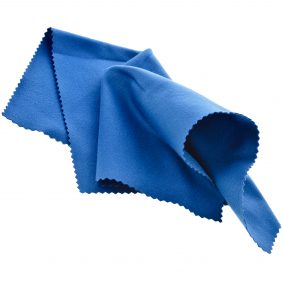Time To Read: 8 minutes
Hearing aids are a modern miniature technological marvel. And like all sophisticated pieces of equipment, they need regular care and maintenance to keep them operating at peak efficiency.
There are two main parts of any hearing aid that need daily attention: the microphone (where the sound enters the hearing aid), and the receiver/speaker (where the amplified sound is delivered to your ear).
With daily wear, these ports can become blocked with wax. If that happens, the hearing aid will not deliver optimum performance.
The easiest way to ensure your hearing aids remain in tip-top condition is to make care and cleaning a daily habit.
Daily Detail
In the evening: Before going to bed, remove your hearing aids and open the battery door to disconnect the batteries. Remember to keep them in their case to avoid them being lost. In the case of rechargables, place your hearing aids in their charger overnight. That means the batteries will be at full strength at the start of the day.
In the morning, use the cleaning brush provided in your kit to remove wax which can accumulate around the microphone and receiver (don’t forget that many hearing aids have two microphones). Wax hardens overnight, making it easier to brush away in the morning.
Brush downwards to help the loosened wax to fall away from the microphones.
Use the supplied cleaning cloth to wipe away any dirt or debris.
 Value Hearing recommends you regularly wash your microfibre cleaning cloth to help clean your hearing aids
Value Hearing recommends you regularly wash your microfibre cleaning cloth to help clean your hearing aidsWeekly Detail
Each week, give your hearing aids a little extra TLC in the cleaning department.
The external casings of your hearing aid may need to be cleaned with a wax pick or a wire loop to gently remove any stubborn deposits. Exercise caution when using the pick around the microphone or receiver ports!
Not all hearing aids are the same. Each specific style of device requires specific cleaning. If you need any assistance with your hearing aids, please do contact Value Hearing, our team is very happy to assist.
Specific devices
Mini Receiver In The Ear/Receiver In The Ear (mRITE/RITE)
These hearing aids have a receiver/speaker that sits in your ear. At the end of the tube is an ear dome. This will need replacing from time to time, along with the white filter which sits beneath it.
To clean the dome, use a wax pick to clear out the holes at the tip of the dome. Do not stick anything longer into the speaker/receiver port, as it can damage the components. Replace the wax filter if needed.
To replace the filter, use the pen-like tool provided with your cleaning kit to remove the filter and use the other end to insert a new filter and then replace the dome.
If the dome gets fully blocked or becomes misshapen, replace the dome as required.
Wipe the outside of the hearing aid with soft cloth.
Tip: Have a dedicated microfibre cloth for cleaning your hearing aids.
Behind The Ear (BTE)
Behind the Ear models also have a tube but do not have the domes. Once you have removed the tubing from the hearing aid, use a vent cleaner to clear out the tubing and vent.
Use the small loop at the end of the wax brush to pick debris away from the sound outlet.
Brush over the microphone ports to remove any loose wax or debris. Then wipe the outside of the hearing aid with soft cloth.
Tip: Use a bulb blower to force the water out of the tubing to promote quicker drying.
Custom Hearing Aids (ITE, ITC, CIC, IIC)
Brush over the microphone and speaker ports to remove any loose wax. Any stubborn spots of wax can be dealt with using a wax pick that comes with your cleaning kit.
Be extremely cautious around the microphone and speaker ports as incorrect use can damage to the components inside.
Pay special attention to the hearing aid vent. Use a vent cleaner to ensure the vent is kept clear.
Tip: Store your hearing aid overnight in its dehumidifier to keep it dry.
Additional Tips
Table Talk - When cleaning your hearing aids, place a hand towel on the surface you’re working at. This protects your hearing aids if they are accidentally dropped.
Coming Clean - Make sure your hands are clean and dry before cleaning your hearing aids. Also, give your designated cleaning cloth a regular wash to ensure you’re not redepositing debris back onto your hearing aids.
Daily Does It - Make cleaning hearing aids a regular part of your daily routine. When it becomes a habit, you’re less likely to forget about it and you can maximise years of trouble-free hearing.
Use The Right Tools For The Job - Use the cleaning kit provided with your hearing aid and don’t improvise. Using water, cleaning fluids and solvents may cause damage, as can using anything other the wax pick and loop provided to clean microphone and speaker ports.
Stay In Touch
At Value Hearing we recommend keeping your six monthly checkup (don’t worry, we’ll remind you). We will take a look at your hearing aids and help ensure they’re operating at peak efficiency.
You can also select which aftercare program is right for you. Some of our clients receive substantial discounts on domes and filters.
And, if you need more assistance, then take a look at our series of hearing aid troubleshooting guide videos.
Further reading
- How To Troubleshoot Hearing Aids
- What to expect from Bluetooth Hearing Aids
- The Truth about Bluetooth (and radiation)
- Can my Bluetooth Hearing Aids get hacked?
- How we ensure your experience is consistent
- What you need to know about Hearing Aid Insurance
- Reduce clinic visits without sacrificing outcomes
- Do I really need such an expensive hearing aid?
- Introducing Bluetooth Hearing Aids

